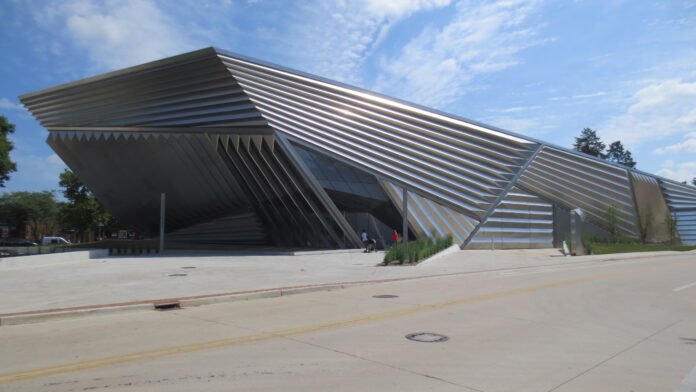In today’s construction landscape, complexity is the new norm. Projects like the Broad Art Museum at Michigan State University, pictured above, with its unconventional shapes and angles, push the boundaries of traditional construction methods. To meet these challenges, Dee Cramer, a Michigan-based HVAC and sheet metal contractor, has turned to advanced technologies such as robotic total stations, laser scanning and reality capture.
Precision and Possibility
These tools are not just about precision; they’re about possibility. As Steve Hunt, VP preconstruction for Dee Cramer recounted in a recent podcast discussion, “The Broad Art Museum really tested our ability to use the current technology we had to its best ability.”
With no square areas to rely on, traditional measuring methods were out of the question. Instead, the team used laser scanning and robotic total station technology to visualize and execute the project with unparalleled accuracy.
“Being able to look at things virtually before you build them for real is essential, especially as unique shapes become more common,” says Hunt.
Collaboration and Problem-Solving
Advanced technologies also bring new opportunities for collaboration and problem-solving. Hunt relates an example of how a dent, a foot and a half long, appeared on a piece of exposed ductwork near the end of a project. This was concerning because the team took great pride in the aesthetics of their exposed ductwork installations. The project team decided to use reality capture technology to investigate the cause of the damage.
By analyzing the captured data, they discovered that the dent appeared the day after another trade had worked in the area. It became clear that the other team, while using a lift, had accidentally caused the damage by going too high, resulting in the lift’s railing denting the ductwork.
Thanks to the reality capture technology, the team quickly identified the problem and collaborated with the other trade to address and repair the damage efficiently.
“In the past, this would have been something that we would have had to address on our own, and it would have been costly,” explains Hunt. “But with reality capture, we were able to identify the source of the problem in about two minutes and partner with another person on the job to rectify the situation.”
Evaluating Technology Integration
But how can you decide which technologies to integrate? At Dee Cramer, professionals evaluate new tools based on their alignment with the existing tech stack and their potential to solve specific project challenges. This strategic approach ensures that the company invests in technologies that enhance their capabilities and deliver tangible benefits.
“It’s really driven by the information we want to leverage across the board with the technology, with our models, with our field teams, connecting our people to get it all back to one central location of information and make that seamless,” says Marcus Ebenhoeh, BIM manager. “It has to align with what we’re doing today and the problem we’re solving.”
For example, when the Leica AP20 AutoPole smart pole attachment for total stations was introduced in 2022, “that piece of equipment seemed like a no brainer to us,” says Ebenhoeh. “It aligned with everything we wanted to do. We saw that it was going to instantly improve our efficiency in the field, which leads to a lot of other ancillary benefits.”
Achieving Remarkable Results
Leveraging advanced technologies enables construction teams to tackle complex projects with greater precision and efficiency. This approach not only enhances project outcomes but also sets new standards for innovation and excellence in the industry.
To learn more, connect with a Leica Geosystems building construction specialist.






